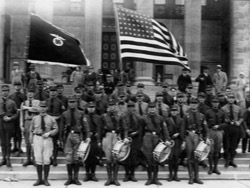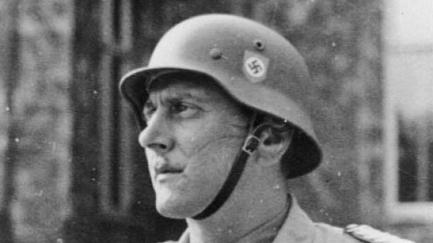
(This article was written by the editor of “CANTONESE news” P. Gilmore. Research and consultations conducted by the Director of the research Department of L. Frank archivist David Rosenberg. A significant part of the article is based on the story of a retired editor “CANTONESE news” George.Lerner, who covered the trial of a conspiracy “GE-Krupp”).
“CANTONESE news” (the print organ of the United workers Union of electrical, radio and engineering USA) – 2000, No. 12. Today, when the power of corporations has increased even more due to global Economics and international trade agreements, is to think about about the behavior of “American” corporations at a time when fascism threatened to plunge the world into the anti-human abyss. The experience of 60 years ago is a powerful reminder of corporate power and greed that cross national boundaries or ignoring Patriotic feelings.
Speaking about the deals “automotive big three” with Nazi Germany, B. Snell wrote: “These firms possessed economic and political power to influence government relationships both within these countries and between these countries to maximize corporate global profits. In short, they were private governments unaccountable to the citizens of any country, and yet has a huge impact on a matter of war and peace in the world”.
Attracting corporate power to account remains the task of all citizens of the world today
1946: Not the first nor the last time a giant company General electric (GE) appeared in Federal court on charges of violation of antitrust law. The U.S. government accused GE and one of her companions in conspiracy to monopolize the market, raise prices and displace competitors.
But it was an unusual antitrust case. In the first postwar year GE appeared in court on charges of collusion with the main German firm on manufacture of arms “Krupp”. Their partnership artificially raised the cost of the defense preparations of the United States. At the same time it was helping to subsidize Hitler’s rearmament of Germany. Cooperation between them continued even after Nazi tanks in the invasion of Poland.
GE was not alone in the world of big business, States in the conclusion of cardiac and profitable agreements with corporations of Nazi Germany. Kodak, DuPont and shell oil are also known friendly business relations with Germany. Thanks to the recent reparations payments, such activity of the companies “Dzheneral motors” (GM) and Ford are the most widely known. And these cases are instructive.
When in 1939 war broke out, GM and Ford with subsidiaries controlled 70% of the German market. Those companies “rapidly retool manufacturing to become a supplier of military equipment for the German army,” writes M. Dobbs in the Washington Post.
“When American soldiers in June 1944 invaded Europe on jeeps, trucks and tanks produced by the “big three automobile” as a result of the implementation of one of the largest ever implemented in military programs, says Dobbs, they were unpleasantly surprised by the fact that the enemy also moves by truck “Ford” and “Opel”, made of 100% subsidiaries owned by GM, and fly on airplanes built by the company “Opel”.
Major car manufacturers in the US (including Chrysler) have established multinational operations in the 1920s and 1930s, placing the plants in Germany, Eastern Europe and Japan.
Friend of the führer, a notorious anti-Semite Henry Ford, has created a kind of mutual admiration society with Adolf Hitler. The German dictator enthusiastically applauded American mass production. “I regard Henry Ford as my inspiration,” said Hitler, who always kept a portrait of this American industrialist in full size on my Desk. In 1938 Ford received the highest award that Nazi Germany could award a foreigner, the Grand Cross of the German eagle.
Ford played a role in the military buildup of Nazi Germany before the war. Military intelligence of the USA reported that the “real goal” of the Assembly plant of trucks, opened in Berlin in 1938, was the production of “military vehicles for the Wehrmacht”.
A senior GM official also received a medal from Hitler, apparently, for the provided and future services. GM involvement in Germany began in 1935, after the discovery of trucks factory near Berlin. After a few years the trucks produced at the plant, will be part of the German army convoys that rumble will pass through Poland, France and the Soviet Union.
After the German occupation of Czechoslovakia in 1939, GM Chairman A. P. Sloan said that the behavior of the Nazis “should not be regarded as governing the case “General motors”. The GM plant in Germany was highly profitable. “We have no right to stop work at the plant,” said Sloan.
Trucks for tyranny
GM and Ford were vital components of the Nazi war effort. German Ford was the second largest producer of trucks for the Nazi military. GM’s plants built thousands of bomber and jet accelerator systems for fighter “Luftwaffe”. At the same time they enriched themselves at the expense of production of aircraft engines for the Air corps of the U.S. Army.
“Sudden outbreak of war in September 1939 led to a complete switch plants GM and Ford in the axis countries for the production of aircraft and trucks”, – noted in the report of the legal Committee of the U.S. Senate in 1974 for a total of subsidiary of GM and Ford built approximately 90% to armored 3-ton poligrasovich and more than 70% of medium and large trucks of the Reich. These vehicles, in accordance with the American intelligence reports, served as “the basis of the transport system of the German army””.
“General motors was far more important to the Nazi war machine than Switzerland,” says researcher B. Snell. – Switzerland was just a repository of looted funds, while GM was an integral part of the war effort of Germany. The Nazis could invade Poland and Russia without Switzerland. But they could not do it without GM”.
To go further
Company officials claimed that the government Hitler took over the management of their German plants and that they “lost control” of the situation. But documents discovered in German and American archives show that, in some cases, American managers like Ford and GM continued to transfer those plants to military production.
“When American soldiers liberated the Ford plants in Cologne and Berlin, they found a poor foreign workers behind barbed wire and company documents extolling the ‘genius of the Führer'”, – writes M. Dobbs.
After the war, as GM and Ford brazenly demanded an indemnity from the U.S. government for damage to their factories in Germany caused by bombing of allied aircraft. In 1967, GM received compensation in the amount of $ 33 million. from the US government for the bombing of the factory “Russelheim”.
Early globalism GE
In comparison with the companies of Ford and GM, the retraction of GE in the cooperation with Nazi Germany was more blatant and extensive than those of automakers. But, nevertheless, it is instructive because it exposes the complex relationship of the GE with the “Third Reich”.
In 1904, GE began to join forces with major foreign “competitors” to divide the world markets of critical goods and technologies. In the same year, GE signed an agreement with AEG. Next year GE year established a relationship with Tokyo electric. GE’s early Alliance with German firms was only temporarily broken by the first world war. GE acquired 16 percent of AEG stock and introduced 4 representatives to the Board of the AEG. GE also received a share in the other big electrical company “Siemens”.
GE’s agreement on patents and owning a minority stake in the German and Japanese corporations protected the domestic market and GE at the same time opened it access to foreign markets.
GE is a conspiracy with the German steel company Krupp had an impact on the military efforts of the U.S. and led her in a new York court.
Both GE and Krupp had patents for tungsten carbide, hard metal composition, which is highly prized for use in cutting dies and machining metal cutting. None of the company’s patent was not sufficient to establish a monopoly. But together they could influence the world market.
Negotiations between GE and Krupp began in April 1928 the GE Representative said that the willingness of company to enter into a new business depends on “the extent to which they will be able to overcome competition.” After 8 months they signed an agreement that gave GE the right to fix prices. GE established a subsidiary company “Carboloy to manage this business.
Immediately price tungsten carbide rose from 48 to $ 453. per pound.
GE used the agreement to harm or redeem shares of domestic rivals. When the head of the company “Ameriken cutting Elloys” asked GE to leave her business, the GE representative told him: “I think it’s clear that the situation on the American market will be better when there will be five suppliers of carbide than six.”
GE in their contract with Krupp agreed to sell tungsten carbide (also known as carboloy) only in the Western hemisphere and to pay royalties to Krupp. The owner of the company Gustav Krupp was a major corporate supporter of Adolf Hitler. Both before and after Hitler came to power GE royalties indirectly subsidized the Nazis.
In 1935, when the U.S. government began defense preparations, tungsten carbide (GE prices) was considered to be too expensive.
Agreed to protect the Nazis
11 Dec 1939 (9 weeks after Hitler’s attack on Poland), the representative of the international GE cabled from Berlin to GE official official Dr. Z. Jaffrezou: “Our friends at “OSRAM” [the German company lighting equipment related to GE] informed me yesterday that Krupp would be interested in the capitalization of the royalties received from now “Carboloy”… In this connection, Dr. Louis (official representative of “Krupp”) wants to meet me in Zurich where we both have to be next week. They were very interested that the name of Krupp was not used in the correspondence, particularly telegrams, which can get in the wrong hands, and thus I have to refer to them in the future or as to the European licensor in accordance with the contract “Carboloy”, or simply, as Dr. Louis …”
“The wrong hands” could be either the US government or the governments of Europe, attacked by Hitler,” reported the newspaper UE NEWS in 1948, in the article “GE has agreed to protect the Nazis”.
“In 1940, when the American defensive effort was in full swing, GE still reported to the Nazi representatives, who moved to Zurich in Switzerland, how much tungsten carbide was used in the United States. GE has paid royalties to the Nazis for every pound used here. It was money for Hitler’s military chest.”
In other words, Hitler received 12 pounds of tungsten carbide for the same price as what the US government was paying for 1 pound. For every pound of material sold in the US, Hitler with the help of Krupp received royalties, which were for the purchase of military equipment.
In 1940, when Europe was at war, Krupp agreed to the collection of royalties from GE through the Swiss intermediary.
Bankruptcy
In August 1940, about a year after Hitler’s attack on Poland, GE has achieved the renewal of its monopoly agreement with Krupp. But the deal “GE-Krupp” came to an end as a result of judicial process and embargoes imposed by the U.S. government for transportation money to the Nazis.
The company of Fers sterling Steele”, who wanted to sell turning blanks for artillery shells the US army, came into conflict with GE on the issue of price level and filed a complaint with the U.S. Department of justice.
In September 1940, “CANTONESE news” reported that the two Federal antitrust indictment proceedings were instituted against GE and the Krupp. They were accused of conspiracy to maintain a worldwide monopoly in the production and sales of tungsten carbide. However, the US entry into the second world war interrupted this.
The fundamental bottleneck
Meanwhile, the sub-Commission of the Commission of the Senate military Affairs for obvious reasons, considered the question of how international cartels prevented the anti-fascist war effort. The Senate Subcommittee charged that the agreement “GE-Krupp” has created a critical shortage in the production of tungsten carbide. “In contrast to the situation in Germany, the lack of this essential material in this country now infamous,” said special assistant to the Minister of justice John.G. Levin. “The need to produce it, to retool our businesses to him, and to train the workers to use such tools led to the creation of one of the main bottlenecks in our production program.”
The country lacked tungsten carbide to meet military needs. And there was other independent producers – GE removed them.
The trial resumed on 26 January 1947 in new York. The accused were the Vice-President of Jeffries Z. GE, the President “Carboloy” by William G. Robbins and former GE trade Manager W. M. Stearns. Gustav Krupp held as a war criminal in Germany, was not present at court, but was also charged.
The irony was that Jeffries accused the leaders of the United Union electricians that they “are pursuing anti-American goals and have high earnings.
The charging document
On the trial in the case of GE, the investigators painfully fought for the introduction in the case of the German documents captured by the U.S. military. In one such document, accusing GE, cited the words of the conspirator William stern, who said to the Germans that, despite the fact that GE intends to establish fixed prices, “this should never be reflected directly in the contract or in any correspondence, which could arrive in files GE.
The court also heard the testimony of witnesses of U.S. companies exposed to pressure GE not to buy from competitors. The President of one such company – Union Weyer Day” – testified that Dr. Jeffries warned him: “We have to either buy your share or to break you.”
Officials of GE and its subsidiaries were found guilty on five counts in a criminal conspiracy with F. from Krupp A. G. of Essen, Germany.
Summarizing the opinion of one of 5 items, judge John.C. Knox said: “Competitors were excluded by purchase and boycott, the price of not having patents, the products were fixed, future patent rights were forcibly formed in the pool, world markets were divided, and in some cases were set firm prices beyond the borders of any claimed patent protection…”
In conclusion, judge Knox said: “the Defendants are on the path of illegal monopolization”.
The clicking of handcuffs
However, the court rejected the petition of the Ministry of justice about the severe punishments, including imprisonment. Stearns and Jeffries were fined $ 2,500. each and Robbins $ 1,000. GE and Carboloy” was fined $ 20,000. each and international GE only $ 10,000., despite the fact that GE profit received through collusion with “Krupp”, probably resulted in many millions of dollars.
Only in 1935 and 1936 a subsidiary of GE “Carboloy” received income 694000 USD.
The irony is that the reports about the trial and condemnation were buried or ignored by many Newspapers, at that time, as GE charges members of the trade Union electricians employed at nuclear power plants, in that they represent potential security risks, were placed on the first page. “CANTONESE news” (circulation over 700 million) was the only newspaper brave enough to constantly cover the trial and to consistently dig the facts of history.
“At a time when American workers threw all their forces to support the anti-fascist war effort, these efforts were constrained by international cartel agreements of big capital,” write R. O. Boyer and H. M. Morais in “the Untold history of the labor movement”.








